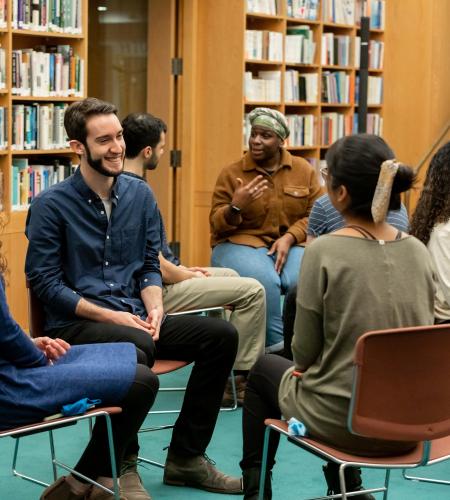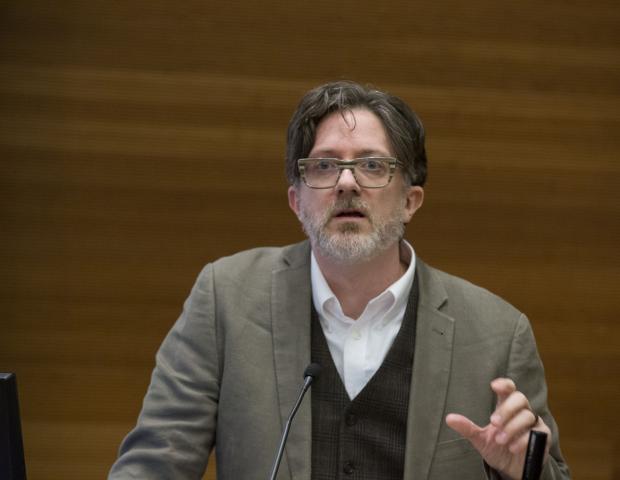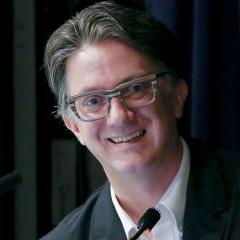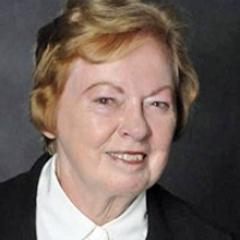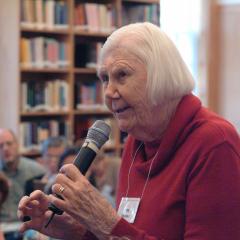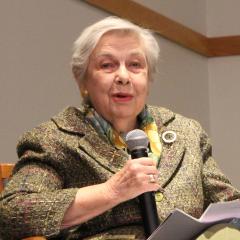But in the context of peace education, I think that the quote that I always gravitate towards from Elise is “we can’t work for a world we can’t imagine.” And so part of the challenge, a big part of the challenge is, you know, how we construct that world in our own minds. And there are tremendous worldview obstacles that get in our way and that make it really difficult for us to see a more preferred future and more preferred reality rather than a probable one, right? So, you know, we take it as sort of fact that that the violence is inevitable. And we have a really difficult time seeing the possibility of cooperative relationships existing as the foundation for culture. So what Elise always encouraged us to do is to release the imagination as part of that process. It’s vital work, but it’s really hard work because our education systems have constrained the imagination of students — the imaginative, the intuitive, that kind of thinking. It’s going back to what we were talking about at the beginning here, these forms of learning have been pushed out of formal educational spaces — where they’re not considered “valid” forms of learning since they are not purely cognitive.
That leads me to the other giant of peace education that I want to talk about, someone we’ve also worked with here, namely Betty Reardon. A few years ago we decided to work together and she really wanted to engage with Mr. Ikeda’s efforts around nuclear disarmament. And the thing she seized on in Mr. Ikeda’s thinking, in his philosophy, was an emphasis on what she described as alternative thinking. And this is what I hear you saying: that we’ve put ourselves in a box and that we don’t know that we can imagine different worlds and that we can actually achieve them. So I was wondering if you could talk a little more about alternative thinking and Betty Reardon and the challenges of our day.
Betty was a really dear, very close friend. You know, in her last few years she was very critical of her own legacy and history of work, and its failures to address the existential crises of our day, nuclear disarmament being at the top of the list, something she had been working on going back to the early 1980s, and trying to bring that focus of disarmament education to peace education. And she saw the intersections of that with climate change. And of course you can always bring in the broader lens of militarism as sort of a third leg of a conjoined existential crises, right? So, yeah, there’s this problem, the challenge of imagination and alternative thinking. Many people have a hard time imagining that other worlds are even possible. And I think it’s rooted in and shaped by our thinking related to change. There’s a certain linearity that most of us hold about how change happens in the world. And part of that sense of linearity is shaped by a certain perception of time and how we perceive the relationships that exist between the past, the present, and the future. So we hold in our minds that the world that came before us has brought us to the present moment. So there’s a certain linearity to that. And the world that we’re living in now shapes our perceptions about the future that we’re moving into. And so forth and so on, and that makes sense based upon the sort of narratives that we’ve constructed in our world. But time is much more dynamic and much messier than that.
So, what I at least would talk about is the ways in which we think about the future actually can reshape the ways in which we perceive the present. And if we’re creative and dynamic, the ways in which we think about the present can reshape the ways in which we interpret the past. So there’s a dynamic relationship that exists. This awareness needs to be part of the process of the pedagogies that we work through to help release the imagination. Because if we’re on that trajectory of linearity, that sort of linear thinking about time, then it’s going to orient us into these deeply probabilistic ways of seeing the future. So it’s kind of like, well, we’ve had a world of violence that’s created the world that we’re seeing that we’re living in now that has all these multiple crises, and that pathway is just going to continue because that’s how things go. So it’s figuring out how to disrupt that thinking and shift it from the probable to the preferred to give space to nurturing positive visions of what the future should hold. And even if those initial visions are wild and crazy and quote, unquote, unrealistic, we need to entertain them. Then we can go back and refine them and think about what might be more realistic in terms of the institutions and the types of relationships that need to exist to get us to that place. That obviously is really difficult work and it really starts with our ability to disrupt those patterns of thought.
Yes, there’s a belief that we’re prisoners of the past. This was a key point for Mr. Ikeda and is central to Nichiren Buddhism, which teaches that every moment provides the opportunity for a fresh start. You’re not a prisoner of the past. Karma is not something that has imprisoned you, but rather karma is what we are creating in this moment. It’s a highly creative, highly liberatory notion, I think. I would like to also talk about another problematic notion. Having done this work for 30 years, it seems to me that the perspective that most cripples us is that of “us versus them,” an inability or refusal to see that we are all in this together.
Yeah. I think that’s really important. I think it’s interesting. So maybe I can talk about this in the broader context of where I see the field of peace education at these days. And I think there have been tremendous developments, over the past 25 years in particular. We see the emergence of a really big cadre of scholars who are doing this work or writing and researching and developing ideas. But there’s a couple of trends that I think have been really important. I look at them with some caution and some concern. So I think there are two significant developments we’ve seen in the last 10 years, and in particular within peace education. First, is bringing emphasis to what a lot of people describe as critical peace education, which has its roots in critical theory and critical pedagogy. It’s about developing the capacities for critical thinking, and doing that kind of learning that helps us see systems of power that exist within institutions and helps unveil forms of structural violence and cultural violence, and so forth and so on. Then I think the other development has been around decolonial peace education, which obviously has a similar intention, but is rooted in deciphering legacies of colonialism and how they shape the world that we live in. These practices and these frameworks tend to orient us towards resistance, and I think resistance is really vital to those injustices to those power imbalances that exist in our world. However, what concerns me is that we’re often not approaching critical and decolonial education with a framework of transformative resistance. And so what happens is it can create, not always, but in some contexts, in many contexts, it can create these situations that lead to the dehumanization of the other — creating that us-versus-them that you’re talking about as opposed to, you know, centering our energy on finding ways to oppose and constructively transform the systems and structures. Otherwise, they may just sustain those old dynamics. As an old friend of mine always would say, you know, where attention goes, energy flows.
So, as this field has gravitated so much attention to critical education and decolonial education one of the things that I see happen, in terms of decolonial studies, is there then is this tendency to categorically reject all Western and modern thought, seeing these forms of teaching and learning and knowing as being inherently bad. Again, and even on the other side of the coin of that, there’s a romanticization of indigenous practices and cultures. So this is a concern for me. And how do we approach that kind of learning in a way that doesn’t create that us-versus-them framing again. I don’t think everyone does this intentionally, but I do see a lot of those kinds of patterns emerge as a result. Betty always called for what I’ve been trying to bring attention back to, which is the importance of nurturing comprehensive peace education. These forms of critical and decolonial and analytic frameworks are foundational to it, but we need to bring those forms of learning and knowing into relationship with social and psychological and educational practices as well. Bringing in and centering the human being, as we discussed earlier, is part of that. And I think where we need to do more work is not just bringing those two frameworks together, but understanding how they’re complementary and inseparable, and how they’re a part of the whole. We have a lot of work still to do.
We also need to look more effectively at the ways in which educational responses need to be trauma informed. Trauma is one of those things that we all experience in life. And there are many different forms of it. And trauma is not just in the mind. It’s even physiological. And trauma can be really difficult to overcome in terms of how it can be an impediment to our own thinking. We don’t often enough find ways to disrupt that victim-oppressor cycle that emerges from traumatic context and conditions. There’s the worldview obstacles I spoke of before, which are things that are nurtured through the formal curriculum, and informal learning through families, through religion and other spaces.
Another concept that I’ll throw into the mix here is deeply related to those two. And I don’t think I’ve seen any really good research on this. We need to better understand how existential anxiety works. It’s a form of trauma in a way. But what I find really challenging in the context of worldview transformation and change is to talk about something like the climate crisis or nuclear disarmament. It feels so overwhelming to people and it produces such a sense of anxiety; and that anxiety is a fear response, and fear rigidifies the ways in which we see and perceive the world. And what it often does is leads to apathy and complacency, and thinking there’s nothing that can be done. So we need to think about how do we nurture learning that helps us overcome that anxiety. And then spirituality would be the fourth prong. I think that needs to be looked at. I think that’s something that Betty was always hesitant to write and talk about, at least formally. But obviously it was a really important part of her work as well; spirituality in the sense of nurturing those senses of interconnection and interdependence that exist between amongst human beings, past and present and future, and obviously ecological relationships as well. So again, how do we nurture this sort of critical emancipatory and transformative resistance that dignifies all that and abhors us moving towards that us-versus-them kind of thinking that you talked about — what can that look like? I think that’s where we need to be putting a lot more energy as we move to the next phases of our work.
Challenges and Victories
A related factor, and challenge, is that we somehow need to get past the fear and the trauma to a situation of trust. This is a very difficult one, but necessary to the cause of peace. As Mr. Ikeda, for whom dialogue was the essential peacebuilding practice, would say: “To have faith in the promise of dialogue is to have faith in the promise of humanity.” So it seems to me that even though trust and that sort of faith are seen as naive, if we don’t somehow develop those, we always end up back resorting to the systems of domination and control. Have you had experiences with trust building and dialogue in your work?
Yeah, absolutely. It’s a conversation I’ve been having a lot with my students recently. And I frequently teach a course on conflict transformation. And that course centers dialogue as one of the fundamental processes through which we transform conflicts. All conflict is relational, so to enter into a space of constructive dialogue, you need to have foundations of trust. So we explore a lot in our conversations different models and practices of the ways in which we do that, how we nurture that trust. And sometimes what conflict transformation looks like isn’t always about directly addressing the issue at hand. Sometimes it’s just sitting down and making commitments to meet at a regular time in a regular place and to follow certain rules. And as you do that over time through sustained interaction and dialogue, you slowly build trust. You get to a place where you can start to have the more meaningful dialogical conversations about the issues that exist between and amongst groups of people. So I think that’s obviously really viable.
How has your thinking about peace education changed from those early days that you described to me?
That’s a good question. I was having a conversation about this a few months back, about a kind of interesting struggle that I’ve been experiencing. Working so closely both with Betty and so many of the founders of the field, and then also with the new generation, means that I’ve been sort of a bridge between these two generations. And there have been tremendous challenges with that, because each generation is coming to it from its own respective experience and context of the world that they’ve been living in. And in fact, up to three or four years ago I was deeply resistant to these efforts that were calling for more critical peace education, for example. I wanted to reject it because I felt like it was missing something. And it’s taken me time to really reflect on what that was based on, on my own way of seeing things. So I think it’s been a challenge for me trying to facilitate these intergenerational dialogues, which I think are really important, and which have been missing for some time in our field.
But how have my ideas evolved more broadly? I’ve probably grown to see how significant these psychological dimensions we’ve been discussing are — much more so than I ever did before. And a lot of that has just come from the direct exposure and experiences I’ve had working with more and more people over the years — and in understanding how important that is. There’s an example that’s really recent that I’m still working through and trying to interpret and understand and make sense of — which is the ways in which a number of our colleagues, who were dedicated peace educators, are evolving in the context of the experience of trauma and violence in Ukraine. Not long ago I was sort of called out by a colleague in Ukraine because I shared an article from a Ukrainian pacifist leader who was being targeted by the Ukrainian government. They were threatening to jail him and he was under house arrest, and still is under house arrest to this day, because he was encouraging nonviolent resistance to struggle. And these friends of mine that I’ve known for many years, decades or more, who I thought of as being, most of them, feminist, pacifist, peace educators were now saying in the context of the struggle that they were working through that there is no room for conversations about nonviolence. What they were saying, essentially, was “our people are dying, and that is an impediment to the kinds of bravery that we need to nurture right now for our survival and our resistance.” And I thought it was really fascinating that they were really aggressively attacking me for sharing these perspectives. But as I zoomed out and began to think about it, you know, again, this is the impact that trauma could have on how you perceive and interact with the world. Trauma disrupts meaning making, right? Trauma is one of those things that we experience that makes it difficult for us to engage in critical self-reflection. The more and more I’ve been studying, and I’m no expert by any means in trauma, but the more and more I study it and even in terms of my own experiences of trauma, the more keen I am to consider how important this is for us to be able to disrupt. Not every situation is the same as the context of Ukraine. As I was picking up on that pattern, I expected to see a similar sort of thing emerge amongst my Israeli and Palestinian peace education colleagues, but they’ve actually doubled down on peace education, which is quite the opposite response.
Interesting.
And I think some of that, and again, this is just hypothetical, my interpretation of this, is that some of that is rooted in the fact that they’ve obviously lived in the conflict situation for 70-plus years. And they have come to see the fallacies of violent resistance as not being effective tools of change and transformation. And so, I think, the only hope that they have for moving forward is to change course and to double down and commit to nonviolence and peaceful alternatives. So I think that’s part of the difference between the two. I mean, there’s probably much more to it than that. But I think that’s part of the story that needs to be looked at. So the evolution has just come from my more direct experience with different peoples and communities working through these different contexts.
So thinking about this and tying it back to Betty — a couple of years ago we did a reissue of her book Comprehensive Peace Education. We had a little book club and conversations about it and Betty joined us for that. And she was being really open about exploring what she perceived to be our failings in our work in peace education. It’s like, why have we not seen the nuclear disarmament world more developed, more robust? Why are we at where we’re at today? And she thought it was a failure of our teaching, of our education and so forth. We didn’t do a good enough job disseminating it, developing it, writing it, conceptualizing it. I said Betty I don’t think that’s it. I mean, I think we can analytically know, cognitively know of the problems of the system, but if we can’t also find ways to overcome that existential anxiety I was talking about a bit ago, we’re not going to be able to move forward. But I’m so grateful for having had the privilege of being able to hear her reflections, frustrations and challenges, and for having had those conversations and dialogues with her, and for having had her mentorship. She was a brilliant teacher, because she did all these things that we’re talking about in terms of how we pedagogically draw things out of each other and engage in dialogue as part of the process of learning. So I don’t know, I think, yeah, I don’t know. This is a rambling way of saying the importance of these psychological dimensions have really stood out for me.
I’ve found that one key element of this is attention to one’s psychological wellbeing. It’s important that each of us do take responsibility for trying to create more peace in the world. Now, I think that each of us can and should find a way to do that, but at the same time, I don’t know how to say this, we can’t take too much responsibility. We have to be easy on ourselves.
Yeah.
This gets to that psychological dimension, I guess. Guarding our health is important.
Yeah, I agree. I fully agree with that. I think Betty was really hard on herself. But she was such a mission-oriented person, working, you know, just like Ikeda — they passed, what, a month apart last year, right? – working right up to her last dying day, doing things that people half her age wouldn’t be capable of doing. And just every day thinking and worrying about it. I think a challenge for me in supporting her being able to navigate from one world to another was helping her to sort of release her sense of that responsibility and to let her know… I just I sat by her bedside saying, you know, the next generation, we’ve got this; and you know, sharing stories of hope with her of how students are looking at and taking action around these issues so she didn’t have to think that she had to do it all. But the responsibility, I think, is important. I do think it’s important that we name those things that are potential failures because we can learn better from them. It’s a bad idea to ignore those things that we didn’t do right. Though I think some people want to.
So there are all these anniversary things that have happened in the last few years. Our Institute turned 40 a few years ago. The Peace Education Commission of the International Peace Research Association, of which Betty was a major initiator, also had a major anniversary. And in all these spaces and places they’ve been having these panels and events, a couple of which I’ve been a part of, and the organizers events have wanted to focus on, well, what have we achieved? We have to name that, of course. Yes. But they didn’t want to talk about the failures. And I guess I can understand that in the context of a celebratory event. But when we don’t also talk about the failures, we’re not continuing to learn from our own past, our own experiences. So, yeah, it’s a challenge.
I would have to say from my experience meeting Betty here, that she maintained a joyful aspect. You’re describing the immense amount of responsibility she felt, but I felt that in here and in the community of the young people she worked with, she felt inspirational. So I think she was doing something right.
Oh, she absolutely was, you know? I mean, I think that probably a lot of those doubtful things came out in private conversations, less so than in public conversations, because pedagogically, she was always manifesting those human-centered principles we spoke of. But then, you know, when she, she was home, her own thoughts often would gravitate towards those failures of what we didn’t do. And I think a lot of it too was, in the last five or six years, part of that was grappling with her mortality and that life transition she was working through and thinking a lot about the legacy of her life and commitments. But, yeah.
Let me pose the simplest question of all to you. What would you like people to know about peace education?
That’s the hardest question in a way! You know, the more you think about a particular field or subject or an idea, the more complicated it becomes. And, so I always find it kind of a challenging thing to express essential ideas. Right? But hopefully I’m getting better at it because, you know, part of my work is academic, so showing complexity and the value of that is important. But also part of my work is advocacy. So it’s about taking that complexity and interpreting it and making it understandable and simple. I think, maybe the message I would give about peace education, particularly for those who aren’t connected to the educational world or peace studies world, is maybe a message nurtured years ago through a campaign we were doing via the Global Campaign for Peace Education. That campaign’s message was rooted in a simple premise: there’s no peace without peace education. And what we were trying to show in particular is that the work of education is essential to the task of nurturing cultures of peace and to dismantling cultures of oppression and violence. And it’s personal work, and it’s interpersonal work, and it’s the work of learning.
And when we look at change that’s happened in the world, we generally talk about things that are significant political milestones, like the signing of a peace accord, as in the case of Colombia, which is really remarkable. It’s the outcome of a political process, yes, but that’s only part of the story. What’s missing from that is the invisible work of both formal and non-formal peace education that was sustained, even in FARC-controlled (1) territories of Colombia, for 40-plus years. And it was that work that led to the cultural groundswelling that began to value peace as an alternative to that legacy of violence. Without that learning, the peace accords might not have been possible. So, you know, I think we need to understand and see our work in that context, and I think it’s really important.
And I would say where I feel really hopeful right now is that there seems to be a global consensus that peace education is vital for addressing threats from the local to the global. Probably the most hopeful thing I’ve been part of over the last few years, and being part of this is actually one of the things that has helped me move through Betty’s transition, is the work that’s come out of UNESCO. In late 2023 a new Recommendation on Education for Peace, Human Rights, and Sustainable Development (2) was adopted and signed by all UNESCO member countries. They are now in the process of rolling out implementation guides for ministries of education and civil society all around the world. It’s a beautifully constructed framework. It’s holistic. It talks about all the different pieces that we’ve been exploring today. But it’s the fact that it has been accepted by all 194 UNESCO member states that is really remarkable. It sets a precedent that this work is vital and important. We haven’t had an instrument like this at a global level in a long time, so that’s something that’s been inspiring me and giving me hope for the future right now.
This, and everything you shared today, is truly encouraging, Tony. Thank you for that. Before we close, is there anything you would like to add?
I would have to say that greatest source of inspiration for me is the students and to see them learning. And quite honestly, what I’ve observed for the last 20 years is that students are showing up now with a greater consciousness, greater awareness of peace and of concepts of conflict, transformation, and violence, than they ever had before. And honestly I’ve learned a ton from them, so that’s what keeps me going.
Notes
1. FARC stands for Fuerzas Armadas Revolucionarias de Colombia — the Revolutionary Armed Forces of Colombia, who engaged in a nearly 50-year war against the state government.
2. https://www.unesco.org/en/global-citizenship-peace-education/recommendation
Resources
Visit the Global Campaign for Peace Education website
Visit the International Institute on Peace Education website
